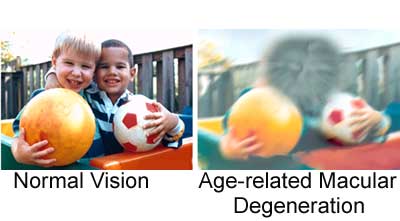- Problems reading books
- Washed out colors
- Blindspots in the central visual field

Image modified from National Eye Institute, National Institutes of Health
The exact cause of AMD is not known. For some reason, the macula fails to receive the nutrients it needs to survive and it degenerates.
| AMD may cause:
|
 Image modified from National Eye Institute, National Institutes of Health |
Did you know? |
There are two types of AMD: Dry AMD: the most common type of AMD; affects about 90 percent of those with the disease. Dry AMD results in a slow loss of retinal cells in the macula. Therefore, central vision is lost slowly. Wet AMD: the less common, but more serious form of the disease because it results in severe vision loss. Wet AMD results when new blood vessels grow behind the retina near the macula. These new blood vessels are weak and may leak blood under the macula. |